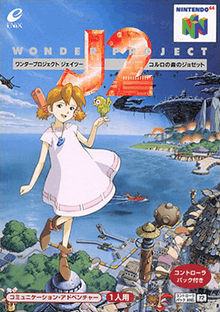Wonder Project J2
| Wonder Project J2 | |
|---|---|
 Japanese Nintendo 64 cover art | |
| Developer(s) | Givro |
| Publisher(s) | Enix |
| Artist(s) |
Akihiko Yamashita (character design) Keiichi Sato (mecha design) |
| Composer(s) | Akihiko Mori |
| Series | Wonder Project |
| Platform(s) | Nintendo 64 |
| Release |
|
| Genre(s) | Life simulation game |
| Mode(s) | Single-player |
Wonder Project J2: Corlo no Mori no Josette (ワンダープロジェクト J2 コルロの森のジョゼット, lit. "Wonder Project J2: Josette of the Corlo Forest") is a 1996 video game for the Nintendo 64. It is a Japan-exclusive Bishōjo and raising simulation game developed by Givro and published by Enix. It is the sequel to Wonder Project J: Kikai no Shōnen Pīno, and was packaged with a game themed Controller Pak.[1]
Story
Wonder Project J2 is a sequel to Wonder Project J. The game's protagonist is a girl Gijin (robot), named Josette, invented by the same Doctor Geppetto who built Pino 15 years prior. Having just completed Josette, the aged Doctor Geppetto had little time left to raise her on his own, so the player assists. The previous game's antagonist, Messala, receives orders from the Siliconian King, Siliconian XIII, to "find the girl who lives on the island of Corlo who is in possession of the J," an object of great power capable of giving Gijin humanity and making highly desired dreams come true. Siliconian armies are dispatched to find the girl at Corlo Island. Geppetto tells Josette to leave the island for the island of Blueland where she will meet someone to help her. Blueland is occupied by the Siliconian Army, which is harvesting Proton, a mineral fuel source.
Gameplay
The player communicates with Josette through her robot, Bird. The player answers her questions on-screen by selecting "yes" or "no". Josette cannot hear or see the player, but learns about the player through successive, binary questions. She recalls the answers later throughout the story. The player can command Josette through Bird, though she does not always listen. Player advancement through the game is dependent on how well their teachings mesh with other activities on the island. After teaching Josette a series of fundamental human interactions, the game's plot-driven second chapter guides Josette through a series of hardships and confrontation with the Siliconian Army.
Release
The game was released on November 22, 1996 for the Nintendo 64.[2] Though the game was initially planned as a Nintendo 64 exclusive, Enix later announced that they were working on a PlayStation version with additional animated sequences which would not fit within the memory limitations of the Nintendo 64 cartridge.[3] However, the PlayStation version was never released.
Some interest was sparked in North America about the game by a two-page article within Nintendo Power Volume #96 (May 1997) called "Epic Center" which featured Wonder Project J2 as one of it last publications before it was discontinued due to a lack of role-playing video games on the Nintendo 64.[4] The game was covered in a one-page feature in Next Generation[5] and a short piece in Electronic Gaming Monthly as well.[6]
A fan translation of the game was made and released in 2007.[7][8]
SquareEnixMobile re-released the game, and Wonder Project J, for download on mobile phones in Japan on April 12, 2010.[8][9] It retailed for 630円.[10]
Reception
Famitsu gave it a score of 33 out of 40.[11] Gamespot gave it a 5.2 out of 10 score.[12] 1up noted that the 3D sections felt awkward.[13] Nintendo Life strongly praised the game.[14]
References
- ↑ "Shoshinkai: Part II". Electronic Gaming Monthly. No. 91. Ziff Davis. February 1997. p. 104.
- ↑ "ワンダープロジェクトJ2 コルロの森のジョゼット | SQUARE ENIX". www.jp.square-enix.com (in Japanese). Archived from the original on 2017-07-21. Retrieved 2018-08-15.
- ↑ "In the Studio". Next Generation. No. 26. Imagine Media. February 1997. p. 34.
- ↑ Takao Imamura, Shigeru Miyamoto (1997). Nintendo Power August, 1997 - Pak Watch E3 Report "The Game Masters". Nintendo. pp. 104–105.
- ↑ "NG Alphas: Wonder Project J2". Next Generation. No. 24. Imagine Media. December 1996. p. 201.
- ↑ "Wonder Project J2". Electronic Gaming Monthly. No. 88. Ziff Davis. November 1996. p. 54.
- ↑ Ryu, "WPJ 2 Translation Project Page" Archived 2007-12-25 at the Wayback Machine., 2007.
- 1 2 "Wonder Project J2 Heading To iPhone - Siliconera". Siliconera. 2010-04-19. Archived from the original on 2016-09-25. Retrieved 2018-08-15.
- ↑ 株式会社インプレス (2010-04-12). "スクエニ、iモード「ワンダープロジェクトJ2 コルロの森のジョゼット」 携帯電話版オリジナルの会話シーンやイラストを収録して登場". GAME Watch (in Japanese). Archived from the original on 2017-08-06. Retrieved 2018-08-15.
- ↑ "『ワンダープロジェクトJ2 コルロの森のジョゼット』がiモードで配信開始 - ファミ通.com". www.famitsu.com (in Japanese). Archived from the original on 2010-06-14. Retrieved 2018-08-15.
- ↑ "ワンダープロジェクトJ2 〜コルロの森のジョゼット〜 [NINTENDO64] / ファミ通.com". www.famitsu.com. Archived from the original on 2017-04-28. Retrieved 2018-08-15.
- ↑ Gerstmann, Jeff (1997-03-13). "Wonder Project J2 (Import) Review". GameSpot. Archived from the original on 2015-11-09. Retrieved 2018-08-15.
- ↑ "Falls from Grace: How Four Creative Game Companies Went Astray from 1UP.com". 2012-11-02. Retrieved 2018-08-15.
- ↑ Life, Nintendo (2014-03-03). "Matters Of Import: Wonder Project J2 Brings Masterful 2D To The N64". Nintendo Life. Archived from the original on 2015-09-06. Retrieved 2018-08-15.